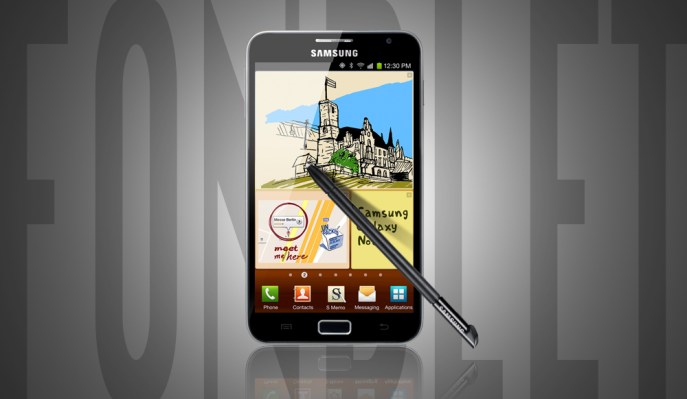Samsung is doing all kinds of crazy things just to get kudos for being ‘First!’ these days, and now it’s added two more “achievements” to that list: coining the terrible term “fonblet” and promising displays that are way, way beyond the capabilities of human eyeballs. During its analyst day in Seoul, South Korea, it’s being far more candid about future plans than is normal, in the hopes of reassuring investors that it continues to expand and rack up growth.
Among its revelations, the company now lays claim to the creation of a “fonblet” market (the term was rumored earlier in the year for a new Samsung device), which is known to most others as the ‘Phablet’ category, or to even more normal people as just ‘large phones.’ The fonblet is a unique and special bird, however, combining not just a huge display with (relative) portability, but also with handwriting recognition – the element which perhaps distinguishes it from mere phablets, and which allows Samsung to lay claim to its creation via the Galaxy Note line of devices.
 Leaving aside that fonblet hits the ears with all the sonorous pleasure of a cat falling down the side of a skyscraper clad in chalkboard, it also combines the word “tablet” with the word “fone,” which as most will be aware, doesn’t actually exist. Maybe the “f” stands for pen.
Leaving aside that fonblet hits the ears with all the sonorous pleasure of a cat falling down the side of a skyscraper clad in chalkboard, it also combines the word “tablet” with the word “fone,” which as most will be aware, doesn’t actually exist. Maybe the “f” stands for pen.
Samsung is also letting on that it plans to increase the resolution of smartphone displays considerably over the next couple of years – first, with WQHD resolution (2560 x 1440) displays next year, and then with 3840 x 2106 screens (aka Ultra HD) sometime in 2015. It sounds nice, but remember these resolutions are planned for devices with roughly 5-inch screens (or slightly larger, if we’re talking fonblets here). As explained by someone much smarter than me (scientist and photographer Bryan Jones) in this article, Apple essentially topped what the average human eye is capable of distinguishing on a smartphone screen at regular use distance with its 326ppi Retina display on the iPhone 4.
In other words, pixel density of 500 or higher starts to enter into “but why?” category, providing advancement for advancement’s sake. If you hold your eyeball right up to the screen, it’s likely going to make a difference, but otherwise, any perceived improvement in quality is likely to be imagined, rather than actual. The real improvement is on the spec sheet, which is where Samsung is hoping consumers are paying attention.
Samsung also said it plans to essentially go back to the drawing board on software and do better, which is something that actually matters, so there’s that. Displays for Superman and terrible neologisms, we could probably do without.
